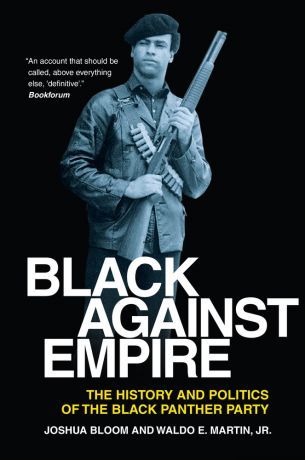Arts
You are here
There is so much to learn from the history of the Black Panther Party

June 6, 2014
The biggest question for anyone who sees the need for the revolutionary overthrow of capitalism is: why are so few people convinced of that need and willing to join a revolutionary organization? Also, what can we do to change that? Black Against Empire: The History and Politics of the Black Panther Party is key reading to address these questions.
In 1966 two college students, Bobby Seal and Huey Newton took up arms and started the Black Panther Party for Self-Defense. Their politics of armed-self defense against American imperialism, both in the US and abroad, convinced thousands to join them and thousands more to support them against the American state. By 1970 the Black Panther Party had grown to have offices in 68 American cities, an international section in Algiers, and meetings with heads of states of sympathetic regimes around the world.
The Panthers were a black nationalist, anti-American, anti-capitalist and anti-imperialist party that played a leading role in national politics in the anti-war movement and in the student movement. They also led neighbourhood politics by setting up breakfast programs for school children, free medical clinics, bus services to visit relatives in prison and intervening with land lords. They were the largest and most influential revolutionary group at that time in America, and with the possible exception of the Industrial Workers of the World in the first two decades of the twentieth century, the most successful socialist revolutionary group in American history. This book combines biographical details of the leading members of the organization along with organizing details of many of the major campaigns of the Panthers.
It also details the scale of the repression organized by the FBI and other police organizations. The SWAT team, beloved of TV and movie writers, was first created by police in Los Angeles to attack a Black Panther office. Carrying military machine guns, riding in armoured cars and dressed all in black, the police fired more than 5,000 bullets into the LA Party office. The Panthers had prepared by lining the walls with sand bags and covering the windows with metal grills to keep out tear gas canisters. After a five hour stand off, the Panthers surrendered.
The state repression also involved provocateurs who joined the Panthers and reported to the FBI. It seems likely that when Chicago police burst into Fred Hampton's apartment at 4:30 AM to shoot him and Mark Clark while they lay in bed, that not only did an informer provide a map of the apartment, but he also managed to drug Hampton to ensure that there would be no resistance. All the bullet holes in the apartment showed that all of the shots came from the police firing into it. To try to cover this up, the police dragged Hampton's body from his bed into the hallway in an attempt to show that the police were fired on.
Despite this repression the Panthers continued to grow in size and popularity. Huey Newton was shot by police in October 1967. While defending himself against the police, one officer was shot and killed. The wounded Newton was arrested and tried for murder. Across the country the Panthers organized rallies to “Free Huey.” As their paper reported at the time, “the police of America have kept black people intimidated, . . . and paralyzed in their bid for freedom . . . They are brutal beasts who have been gunning down black people and getting away with it. . . . We say that black people in America have the right to self defense. Huey Newton has laid his life on the line so that 20,000,000 black people can find out just where they are at and so that we can find out just where America is at.” The “Free Huey” campaign mobilized thousands to support the Panthers and exposed the racist nature of the American state.
The Black Panthers became a leading force in student strikes and in the anti-war movement. They also started a wider organization that was open to anyone not only blacks. After organizing a successful conference on to develop a “united front against Fascism,” the Panthers set up National Committees to Combat Fascism around the country. By April 1970 there were at least 18 such committees across the US.
Despite all this, in the first few months of 1971 the party became to come apart. A wing devoted to armed uprising against the police and the state immediately was expelled from the party and the remainder backed off from the politics of armed self-defence, and revolutionary politics instead turning to elections. The armed uprising faction could not grow, or win support, and they certainly couldn’t defeat the US state on their own. The more moderate electoral politics of the remainder had little to offer black Americans facing day to day poverty and harassment by the police. By 1972 the party's membership and influence were dwindling and the leadership put all of their resources into the 1973 election for Mayor of Oakland which they lost in a run off election. The party continued to have some influence in electoral politics in California, but never regained the position of leadership it once had. At the time, the politics of armed self-defence was a brilliant tactic. It answered the immediate need for black people to resist the racist state, and gained support of much wider sections of society who could see how necessary this was. At the same time it did not grant the legitimacy to state repression that a politics of armed attacks on the state would have.
Today we must ask ourselves what actions can we organize to win legitimacy for revolutionary politics? Anyone who wants to build a revolutionary organization today should study this history of the Black Panthers.
Section:










